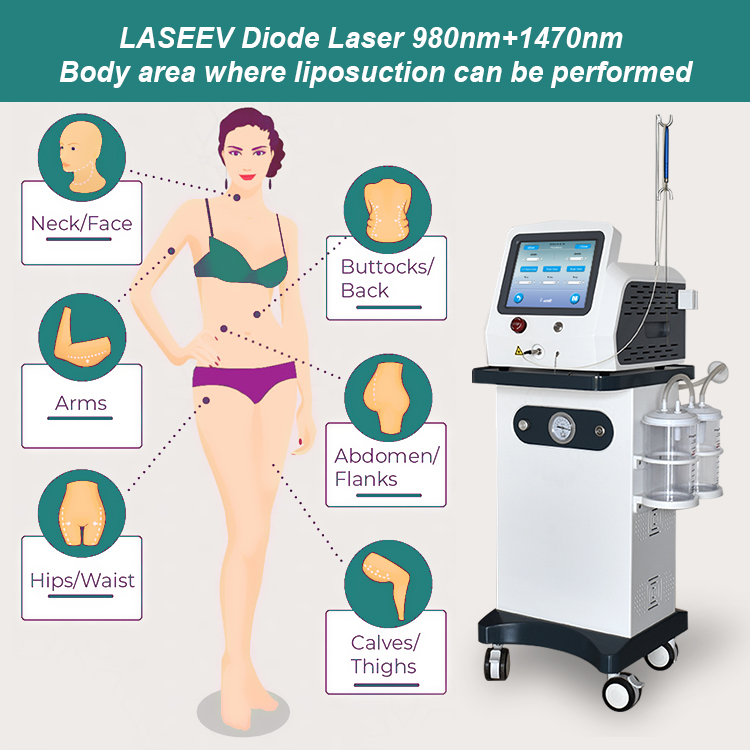Lipolysis laser technologies were developed in Europe and approved by the FDA in the United States in November of 2006. At this time, laser lipolysis became the cutting edge liposuction method for patients desiring precise, high-definition sculpting. By using the most technologically sophisticated tools in the cosmetic surgery industry today, Lipolysis has been able to provide patients with a safe and effective means of achieving a contoured.
Lipolysis laser utilizes medical-grade lasers to create a light beam powerful enough to rupture fat cells and then melt the fat without traumatizing nearby blood vessels, nerves, and other soft tissues. The laser functions at a specific frequency to produce the desired effects on the body. The sophisticated laser technologies are able to keep bleeding, swelling, and bruising to a minimum.
Laser lipolysis is a high-tech liposuction method that produces results superior to what’s possible using traditional liposuction techniques. Lasers are precise and safe, doing their work by emitting a powerful beam of light at fat cells, liquefying them before they are removed from the targeted area.
Liquefied fat cells can be suctioned out of the body using a cannula (hollow tube) with a tiny diameter. "The small size of the cannula, using during Lipolysis, means that no scars are left behind by the procedure, making it popular with both patients and surgeons" - said Dr. Payne founder of Texas Liposuction Specialty Clinic.
One of the major benefits of Lipolysis is that use of lasers help tighten up the skin tissues in the areas being treated. Loose, sagging skin can create bad results after liposuction surgery, but lasers can be used to help increase the elasticity of dermal tissues. At the end of the a Lipolysis procedure, the doctor points the laser beams at the skin tissues to encourage the development of renewed and healthy collagen. The skin tightens up in the weeks following the procedure, translating into a smooth, sculpted body contour.
Good candidates should be non-smokers, in good general health and should be close to their ideal weight before the procedure.
Because liposuction is not for weight loss, patients should be seeking out the procedure to sculpt and contour the body, not to lose pounds. However, some areas of the body are particularly prone to storing fat and even dedicated diet and exercise programs may fail to get rid of these fatty deposits. Patients who would like to get rid of these deposits might be good candidates for Lipolysis.
More than one area of the body can be targeted during a single lipolysis procedure. Laser lipolysis is appropriate for a variety of different areas of the body.
How does Lipolysis Work?
Lipolysis utilizes medical-grade lasers to create a light beam, powerful enough to rupture fat cells and then melt the fat without traumatizing the surrounding blood vessels, nerves, and other soft tissues.
As a form of Laser Liposuction, the principle behind Lipolysis is to melt the fat by the use of thermal and photomechanical effects. The laser probe works at different wavelengths (depending of the Lipolysis Machine). The combination of wavelengths is the key in liquefying the fat cells, help in coagulation, and promoting the posterior skin tightening. Bruising and blood vessel destruction is kept to a minimum.
Laser Liposuction Wavelengths
The combination of laser wavelengths is determined according to the objectives planed by the surgeon. A combination of (980nm) and (1470 nm) laser light wavelengths is used to disrupt the adipose tissue (fat cells) with a minimal recovery time in mind. Another application is the simultaneous use of the 980nm and the 1470 nm wavelengths. This wavelength combination aids in the coagulation process and later tissue tightening.
Many surgeons recur to tumescent anesthesia. This provides them with an advantage later when performing the fat melting and its posterior extraction (suction). The tumescent swells the fat cells, facilitating the intervention.
One of the major advantages is the disruption of fat cells with a microscopic cannula, which translates into minimal invasion, tinny incisions and almost not visible scars.
The liquefied fat cells are then extracted with the cannula using a mild suction. The extracted fat flows through a plastic hose and is captured in a plastic container. The surgeon can estimate how much volume of fat has been extracted in (milliliters).
Post time: Dec-29-2022

